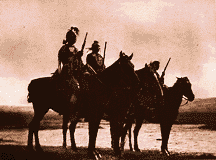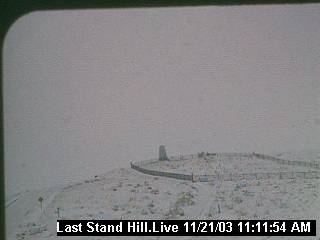|
 |
| General George A. Custer was
born in New Rumley, Harrison County Ohio, on Dec. 5 1839. He spent most of
his childhood with a half-sister in Monroe, Michigan. After he
enrolled at West Point, where he failed to make himself look good in any
positive way. Several days after graduating last in his class, he
failed in his duty as officer of the guard to stop a fight between two
cadets. He then graduated the U.S. military academy in June of 1861 and
then went to Washington to work. He was in the First Battle of Manassas.
His next mission given to him by General Winfield Scott gave him things to
carry to General Irwin McDowell. After this they put him in command
of the Army of the Potomac, he was assigned lieutenant in the 5th cavalry.
On Sept. 30 he began command of the 3rd division of cavalry and fought a
good battle of Woodstock on Oct. 9. After this he was court-martialed and
saved from punishment because of the need for officers with the start of
the Civil War. |
|
| At the start of the Civil War he
fought against his former classmate at West Point the Confederate General
Rosser. "Let's kick their ass and get the Hell out of here."
Custer drove them back 26 miles and he captured everything on wheels
except one gun. His cavalry units played a critical role in forcing the
retreat of Confederate General Robert E. Lee's forces; in thanks, General
Philip Sheridan purchased and made a gift of the Appomattox surrender
table to Custer and his wife. In a general order addressed to his troops
at Appomattox Court House, April 9, 1865 General Custer said: "During
the past six months, though in most instances confronted by superior
numbers, you have captured from the enemy in open battle 111 pieces of
field artillery, 65 battle-flags, and upward of 10,000 prisoners of War,
including seven general officers. Within the past ten days, and included
in the above, you have captured 46 field-pieces of artillery, and 37
battle-flags. You have never lost a gun, never lost a color, and never
been defeated; and notwithstanding the numerous engagements in which you
have borne a prominent part, including those memorable battles of the
Shenandoah, you have captured every piece of artillery which the enemy has
dared to open upon you." Custer did unexpectedly well in the Civil
War. He fought in the First Battle of Bull Run and served with panache and
distinction in the Virginia and Gettysburg campaigns. Although his units
suffered enormously high casualty rates even if it was the Civil War, his
fearless aggression in battle earned him the respect of his commanding
generals and put him in the public eye. He then applied to the government
for permission to accept from President Juarez the place of chief of
Mexican cavalry in the struggle against Maximilian. President Johnson
declined his leave of absence and Custer was appointed
lieutenant-colonelcy of the 7th cavalry, he then joined his troops at Fort
Riley. |
|
| After the Civil War in 1865 Fort
Riley, Kansas was important in providing protection to the railroad lines
being built across Kansas. The importance was realized in the summer and
fall of 1866 when the Union Pacific Railroad reached Fort Riley and the
7th Cavalry Regiment, commanded by Colonel Andrew J. Smith was grouped at
the fort. On April 15, 1865 he was appointed the "Brevet" rank
of Brigadier General of Volunteers. He was also put in command of the 2nd
Brigade, 3rd Cavalry Division at Gettysburg and Yellow Tavern. He
commanded the 3rd Cavalry Division in the Shenandoah Valley, Fisher's Hill
and Five Forks. After the War, Custer had to revert to his old permanent
rank of Captain. Then he went through the slow promotion process that usually
happened in the small regular army. That's why Custer was always called
"General Custer". In 1867 one of Custer's first official acts
with the 7th Cavalry was to make a regimental song. He liked "Garry Owen"
and that's why it was chosen. In March 1867, when Indian attacks became
more violent, the 7th Cavalry was given its first opportunity to see what
fighting Indians was all about. Under the command of General Hancock, they
marched from Fort Riley to Fort Larned. They were joined by 6 infantry
companies and a battery of artillery creating a task force of over 1400
men. "There are not enough Indians in the world to defeat the 7th
Cavalry." In April 1867, a meeting was held between the Army and a
few chiefs of the Plains Indians. The Army moved their troops closer to an
Indians encampment and thought they were being attacked and fled under the
cover of night. |
|
| Custer and the 7th Cavalry,
given the task of tracking the Indians down, he spent the whole summer in
the attempt to find them. The only contact they made with the Indians were
with small war parties which wouldn't stop harassing the troops. In this
campaign, Custer left his command in the field and traveled back to Fort
Riley to visit his wife. Upon arrival Custer was court-martialed and found
guilty. He was sentenced to one year suspension from rank and pay. He went
home to Monroe, Michigan where he waited out his suspension. On Sept. 24
1868, Custer's court-martial was take off and he went back to his troops
on Bluff Creek. As soon as he arrived Indians attacked his camp. Custer
and his troopers gave chase and followed the Indians trail back to Medicine
Lodge Creek, and found no Indians at all. |

|
|
| They planned an attack. If the Indian Villages
were hard hit and supplies destroyed they would have to return to their
reservations or starve. During winter months the Indians would stay close
to a good source of water and firewood for heat; they just had to find it.
Sheridan's plan involved 3 columns: Colonel Andrew W. Evans with six
troops of the 3rd Cavalry and two companies of the 37th Infantry were to
go down the South Canadian River. The second column was seven troops of
the 5th Cavalry under the command of Major Eugene A. Carr. They marched
southeast from Fort Lyon, Colorado and meet Captain William A. Penrose and
his column of five troops of cavalry. They stayed at Antelope Hills, along
the North Fork of the Canadian River. The third column was to march from
Fort Dodge under the command of General Sully and George A. Custer.
Sheridan chose the 7th Cavalry and Custer to take the lead. Custer
followed tracks to the Washita River. It was Chief Black Kettle's village,
well within the boundaries of the Cheyenne reservation. on the 27th of
Nov. in 1868, Custer charged and Black couldn't escape. Colonel Andrew W.
Evans struck another Comanche village at Soldiers Spring on Christmas Day.
The campaign was successful against the Cheyenne in the Oklahoma
Territory. |
|
| In Feb. 1873 Custer got the good news that the
7th Cavalry was going to be together and sent north to Fort Rice in the
Dakota Territory. His mission was to protect settlers in the region and
the engineers of the Northern Pacific Railroad who were looking at a rail
route across the Yellowstone River from the Sioux Indians. The completion
of the railroad link provided an easy way of transportation for gold seekers
and farmers to come to the area. The Sioux gave the migration problems. On
June 20 1873, they moved into the Black Hills of Dakota to have protection
from the railroad constructors. As a point of scouting activities a
permanent stay was established at Fort Abraham Lincoln south of the Mandan
from 1873-1876. Custer led his troops into the Black Hills and found gold.
The government offered to buy the land but the Sioux wouldn't sell it. The
Army allowed gold prospectors to come into the Reservations hills by the
thousands. The Sioux left and joined Sitting Bull and Crazy Horse in
Montana who were resisting white government control. |
|
| The 7th Regiment left Fort Lincoln
on the 17th of May in 1876, with Custer along with Arikara and Osage
scouts leading the way. General Terry was to trap the Indians between
Custer and Major General John Gibbon in the Little Big Horn Valley. Custer
had been ordered to move a band of Indians toward the large cavalry force.
Custer needed to pass all the way down the Rosebud Creek and cross over to
the Little Big Horn Valley and move north, to prevent the Indians from
escaping south. After making visual contact with the Indians on June 23,
Custer ordered the column to turn west toward the Little Big Horn Valley.
Arikara and Osage scouts identified a party of Sioux following them The
Sioux fled when approached and Custer didn't want any of the Sioux to
escape. The night of June 24, Custer told the plan for the next day. When
they got to the Sioux on June 25 1876, Custer made a decision to attack
and fight the Indians. On the verge of what seemed to him a certain and
glorious victory for the U.S. and Custer he ordered an attack on the
Indian village. "Hurrah boys! We've got them." Within a short
period of time, Custer and his troops were annihilated by the full might
of an estimated 5,000 Sioux Indians who were led by Chief Sitting Bull and
Chief Crazy Horse. |
|
| Custer died in Montana, on June 25
1876 at the Battle of the Little Bighorn. Custer's mistakes cost him his
life but gained himself a lot of fame that won't be forgotten. His defeat
at the Little Big Horn made his life of what would have been a forgotten
19th century military figure into the talk about in songs, books and
paintings. His widow Elizabeth B. Custer did what she could to make his
reputation better. Writings of his life that portrayed him as a military
genius but a good man. A picture showed Custer like a victim surrounded by
bloodthirsty savages intent upon his death. Forgotten was that he started
the battle by attacking the Indian village and that most of the Indians
present had to surrender within a year of the greatest battlefield achievement. |

|
|
| Jose Cavazos
8th American History
Rossville Jr. High
Plains History Project
2004 |
Bibliography |
|